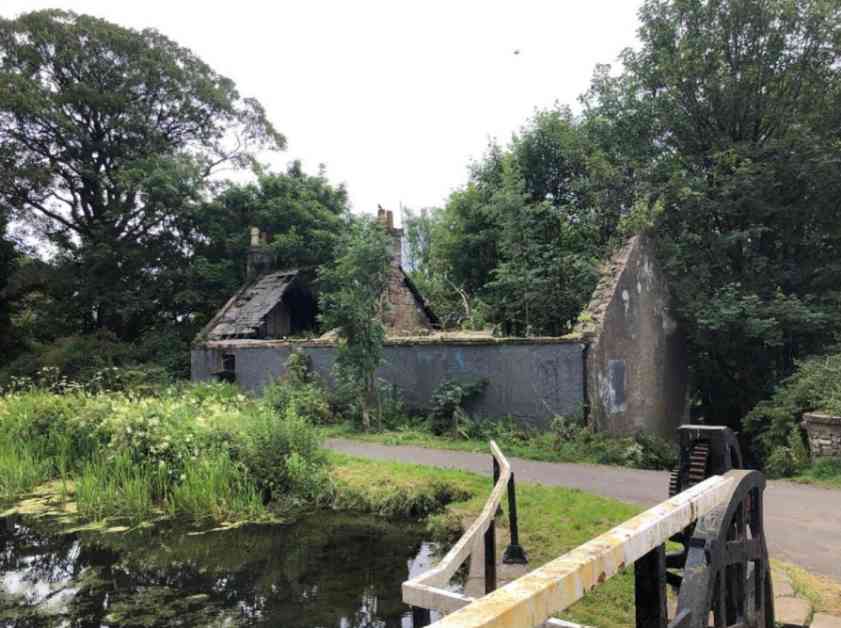Plans for renovating an abandoned cottage into a family home have been met with both approval and objections from various stakeholders, sparking a debate over the future of the historic Ferry Dykes Canal House in West Dunbartonshire, Scotland.
Approval Despite Objections
Despite objections from the Scottish Environment Protection Agency (SEPA), West Dunbartonshire Council’s planning committee has given the green light to the application for the re-establishment of Ferry Dykes Canal House, also known as Ferrydykes Cottage. This decision comes after the cottage has sat empty for several years, becoming a target for vandals who set it alight on two occasions.
The owner of the property, who purchased the building in 2006, is seeking to transform the derelict structure into a four-bedroom family home. The proposed plans include extending the property to add a one-story porch and reinstating the two-and-a-half-storey home to create a comfortable living space for a family.
Community Support and Optimism
The Old Kilpatrick Community Council has expressed their delight at the prospect of the abandoned cottage being brought back to life as a family home. They view the renovation as a positive step towards revitalizing the historic part of the village and hope that it will encourage further development in the area.
The community council’s submission to the planning committee highlighted the detrimental impact the derelict cottage has had on the canal and its surroundings. They believe that transforming the building into a family home will not only improve the visual appeal of the area but also contribute to the overall community development.
SEPA’s Objection and Concerns
However, not everyone is on board with the proposed renovation plans. The Scottish Environment Protection Agency (SEPA) has raised objections to the project, citing concerns over the potential risk of flooding to both the occupants of the house and neighboring properties.
SEPA’s objection is based on the belief that allowing people to reside in the cottage could put them in a dangerous position, especially in the event of flooding. They have recommended that the plans be reviewed to address these safety concerns before proceeding with the renovation.
Council Decision and Controversy
The decision to approve the renovation plans was not unanimous, with Lawrence O’Neill, a Kilpatrick Councillor and convenor of the planning committee, voting against the proposals. O’Neill expressed reservations about the safety implications raised by SEPA and believed that more precautions needed to be taken before moving forward with the project.
Despite O’Neill’s objections, the majority of the committee members voted in favor of the renovation plans, with only one submission against them. The committee members were reassured by the proposed drainage and tanking measures that would be implemented to mitigate any potential flooding risks.
Future Steps and Government Intervention
The ball is now in SEPA’s court, as they have the option to refer the matter to the Scottish Government for further review. If SEPA decides to escalate the objection, the Scottish Government will have the final say on whether the renovation plans can proceed as approved by the council committee.
SEPA’s objection has raised questions about the balance between historical preservation and environmental safety in the context of renovation projects. While the community sees the renovation of the cottage as a positive step towards revitalizing the area, concerns about flooding risks have cast a shadow of uncertainty over the project.
Moving Forward
As the debate over the future of Ferry Dykes Canal House continues, it is clear that finding a balance between historical preservation, community development, and environmental safety is crucial. The renovation of the abandoned cottage into a family home represents a significant opportunity to breathe new life into a neglected part of the village.
The differing viewpoints of stakeholders, from the community council to SEPA, highlight the complex considerations that come into play when undertaking such projects. As the renovation plans move forward, it is essential that all concerns are addressed and that the safety of future residents and neighboring properties is prioritized.
In Conclusion
The approval of the renovation plans for Ferry Dykes Canal House marks a significant step towards transforming an abandoned cottage into a vibrant family home. While objections from SEPA have raised valid concerns about potential flooding risks, the majority decision by the council committee reflects a belief in the positive impact the renovation will have on the community.
As the project progresses, it will be crucial for all stakeholders to work together to ensure that the renovation of the cottage is carried out with the utmost care and consideration for the safety and well-being of future residents. With careful planning and implementation, the renovated cottage has the potential to become a beacon of revitalization in the historic village of Old Kilpatrick.















